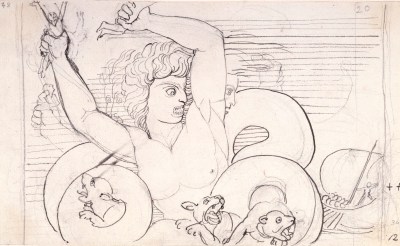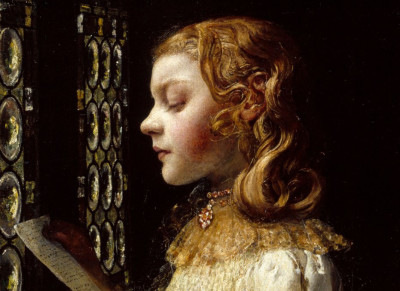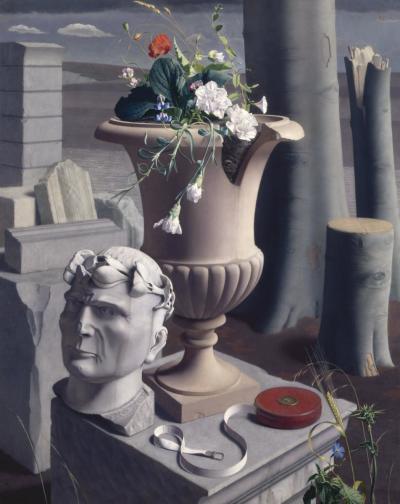How to read it: Thomas Lawrence’s Satan Summoning his Legions
How to read it: Thomas Lawrence’s Satan Summoning his Legions
Short read
By RA Collections team
Published 7 June 2018
As you enter the RA’s new Collection Gallery, a very large (and slightly absurd) figure of Satan towers over you – in what looks suspiciously like the Tory “power stance”. Here’s the story behind the painting…
-
-

Satan’s painter was a young buck
– it may not surprise you to hear. Sir Thomas Lawrence became a Royal Academician at the age of 24 (our youngest living Academician today was elected at 36, just for reference). Renowned for his glamorous and flattering portraits of the rich and famous, he went on to become a leading painter of his day and President of the Academy – but Lawrence painted Satan before that. Aged 26, he took the bold step of trying the history painting genre – scenes showing classical myths or historical events, considered “High Art” – for the RA’s annual exhibition, now the Summer Exhibition. His vision of Satan is naked apart from a sword, helmet and some carefully positioned drapery – and he didn’t look any less absurd back in the 18th-century. More on this later…
The painting depicts a single line from Paradise Lost
– John Milton’s epic poem: “Awake, arise, or be for ever fallen”. With these words, the rebel angel, Satan, who had been banished to Hell, rouses his followers to try and regain Heaven.
Artists had long drawn inspiration from Paradise Lost, but depictions increased notably in the 1790s, with artists such as Henry Fuseli and James Barry among those taking up the subject. One obvious reason was the French Revolution, which began in 1789 and was seen from afar with great interest by British artists. Milton’s Satan, resisting the rule of the Almighty, was often viewed as the embodiment of revolutionary spirit. William Blake expressed this view in 1790: “The reason Milton wrote in fetters when he wrote of Angels & God, and at liberty when of Devils & Hell, is because he was a true Poet and of the Devils party without knowing it.”
By the time Thomas Lawrence painted Satan in 1796, according to the art historian David Bindman the French Revolution had begun “to appear even more Miltonic, as destruction, chaos and envy seemed to attend it as they did Satan in his travels across the universe”. Despite its topicality, Lawrence’s choice of a Miltonic theme was also rooted in his own past – he first encountered Paradise Lost as a child and had made drawings of Satan many years before working on this painting.
-
-
The reason Milton wrote in fetters when he wrote of Angels & God, and at liberty when of Devils & Hell, is because he was a true Poet and of the Devils party without knowing it.
William Blake
-
-
Lawrence used a bare-fist boxer
named John Jackson (also known as “Gentleman Jackson”) to model as the figure in his earlier painting, Homer Reciting his Poems, and according to some accounts, Jackson was also the model for the rippling torso of Satan. The boxer had by this time demonstrated something of a Satanic streak himself; in 1795 he became the English champion after defeating his opponent by seizing his hair and pummelling him into submission.
At the time, the depiction of the male nude was considered the ultimate test of an academic painter’s skill – and the more muscly the better. As Tate Britain curator Martin Myrone has shown in his book, Bodybuilding, “this was a moment in which men recognised the absurdity and irrelevance of masculine archetypes drawn deep from history, the brute heroes and supermen of ancient myth, but stopped caring”. One of Myrone’s examples of this heroic masculinity is Henry Fuseli’s Thor Battering the Midgard Serpent, which hangs alongside Satan in the Collection Gallery, and which Lawrence was accused of plagiarising.
Lawrence’s embrace of this absurdity is evident in Satan – particularly when looking at it alongside a preparatory drawing for it in the RA collection. In the drawing, Satan stands demurely, left foot forward – which Lawrence then clearly abandoned in favour of a wild, legs-spread pose that’s eerily reminiscent of the “power stance” beloved of Tory politicians.

-
-
-

Lawrence had a messy love affair with two sisters
at the time he was working on Satan – daughters of the celebrated actress, Sarah Siddons. Lawrence started an affair with Sally Siddons in 1796 which culminated in a marriage proposal, but later became engaged to her sister, Maria Siddons, in 1798. Maria is thought to have been the model for the girl stealing a chicken in Lawrence’s Diploma Work, A Gipsy Girl, although this work predates their romantic involvement. Sarah Siddons was deeply disturbed by Lawrence’s advances towards her daughters, and stubbornly refused to allow either one to marry him. Perhaps for this reason, Lawrence is said to have originally included a likeness of Sarah Siddons at the feet of Satan, before thinking better of it. Lawrence is also said to have based the head of Satan on Sarah Siddons’ brother, the actor John Philip Kemble – so we can only imagine how the girls’ uncle had reacted to the affair.
-
-
Satan was widely panned by the critics
“A mad German baker, dancing naked in a conflagration of his own treacle,” is how one satirist and critic, John Williams, described Satan, when he was first unveiled at the 1797 Summer Exhibition. Williams said the picture was: “a melange, made up of the worst parts of the divine Bonarotti [Michelangelo], and the extravagant Goltzius: the figure of Satan is colossal and very ill drawn: the body is so disproportioned to the extremities, that it appears all legs and arms, and might, at a distance, be mistaken for a sign of the spread eagle. The colouring has little analogy to truth as the contour, for it is so ordered that it conveys an idea of a mad German baker, dancing naked in a conflagration of his own treacle!” Look out for a scene of Williams delivering this verdict in The Optickal Illusion, a recent historical novel by Rachel Halliburton. Perhaps the worst criticism of all, though, came from a fellow artist, John Hoppner, who reportedly offered £100 to have the painting removed from the Summer Exhibition.
But Lawrence still thought it was great.
Painting almost every prominent person of the day, Lawrence went on to become the President of the Royal Academy and the leading portrait painter in Regency Britain – but he never painted another picture like Satan. You might imagine that was because he looked back at it as a heroic failure, and proof that he was indeed no history painter. In fact, Lawrence was either completely oblivious or completely unmoved by his critics, writing in 1811, around 15 years after he painted Satan, that “it is such as neither Mr. West, nor Sir Joshua, nor Fuseli could have painted”, and went on to share his regret at not producing more works in this vein. Just think how pleased he’d be to see Satan summoning our visitors as they approach the new Collection Gallery.
-
-

Come and visit Satan in person...
The Making of an Artist: The Great Tradition
Thomas Lawrence’s Satan Summoning His Legions is on display in our new Collection Gallery. This free display features treasures of the Royal Academy, including Michelangelo’s only marble sculpture in the UK, the Taddei Tondo.
-







